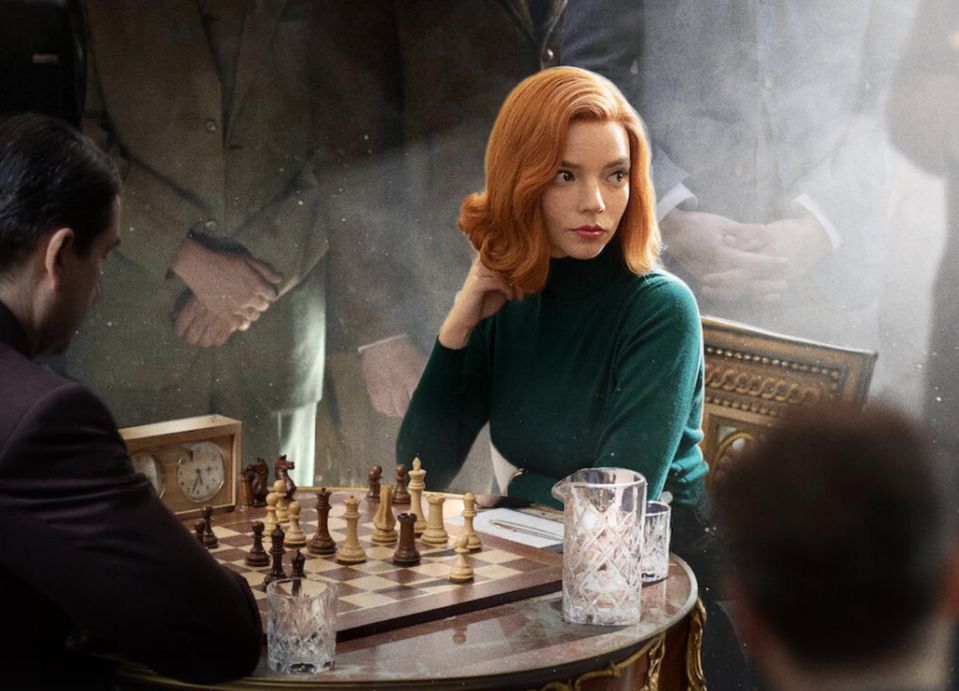Our Take: 5 Stars
The premise of “The Queen’s Gambit,” a seven-episode Netflix miniseries, is simple: Elizabeth Harmon (Anya Taylor-Joy, “Emma”) rises from the obscurity of orphanhood and femalehood in the mid-20th century to make a name for herself by being very good at chess. Beth is also deeply troubled, and a spiral into addiction accompanies her ascent to stardom.
The first episode of the series introduces the viewers to a young Harmon, played with remarkable potency by Isla Johnston (“Kiri”). After a tragic car accident that leaves her an orphan, Harmon joins the Methuen School for Girls. There, Beth meets the strait-laced Mrs. Deerdorf (Christiane Seidel, “Godless”), the foul-mouthed, big-sister figure Jolene (Moses Ingram, “Day 74”) and a surly janitor named Mr. Shaibel (Bill Camp, “Joker”). Also at Methuen, Beth encounters the two dominant influences of the series: chess and the green tranquilizing pills that the school gives the girls.
When Beth stumbles upon Mr. Shaibel playing chess in the basement, the game captivates her instantly. Mr. Shaibel recognizes Beth’s natural genius for the game, heightened by her nightly pill-induced hallucinations. It doesn’t take long for her to outplay him, and then the high school chess club’s teacher, and then the entire club itself.
Fast forward a few years, and Allston (Patrick Kennedy, “Mrs. Wilson”) and Alma Wheatley (Marielle Heller, “MacGruber”) adopt Beth, while Jolene is left behind. Beth is still settling into her new life when Allston abandons his wife and adoptive daughter. Alma, a talented pianist and chronic drinker, is left to chaperone her daughter — and pocket a portion of her paycheck — as Beth’s chess career takes them around the country and to ever-increasing heights of luxury.
But Beth’s cripplingly self-destructive tendencies and violent addictions plague her rise to celebrity. The main thread of the plot often intersperses with her memories of her mother’s descent into madness and eventually suicide. Charismatic men weave in and out her life, but they cannot seem to decide if they are more enamored of her or of her dazzling ability.
As chess becomes Beth’s obsession and her means of controlling a world that has slipped away from her too many times, the series explores genius, madness, trauma, family and the things that bind them all together. Beneath the layers of glamor and confidence, Beth returns time and again to the same question: without winning, who is she?
“The Queen’s Gambit” has been described as a coming-of-age tale as it follows Beth from her tragic childhood, through her years of teenage prodigy, to a conclusion that finds her at the pinnacle of her game. But the thing that gives the series its sparkle and makes it as addictive as one of Beth’s green tranquilizers has little to do with the plot.
The series even manages to make a game that involves pieces gliding across a board indecipherably — at least to a novice — into a riveting piece of drama.
The matches are so beautifully shot, lit and edited that one cannot look away, even without knowing what is going on.
World Chess Champion Garry Kasparov and chess coach Bruce Pandolfini consulted on the series, and the games were based on actual matches.
“The Queen’s Gambit” takes the viewer on a journey, first to Cincinnati, Las Vegas, New York, then to Paris and Moscow.
Every scene and location in the film is shot with impeccable elegance and striking precision, evoking the old-timey glamor of Hollywood in the 60s.
Everything that happens on screen is intentional, lending weight and quiet tension to even the most subtle moments.
The series’ graphics, which play with black-and-white symmetry of a chessboard, are worthy of note.
Apart from visual aesthetics, the show also distinguishes itself auditorily with a strings-heavy soundtrack composed by Carlos Rafael Rivera that jumps sinuously from the tension and drama of a chess game, to tragedy of a loss, to the pathos of Beth’s story.
Rivera’s score is interspersed liberally with oldies — “End of the World” (Herman’s Hermits), “Fever” (Peggy Lee) and “Venus” (Shocking Blue), to name a few — that add dimension and sensitivity.
The crowning achievement of “The Queen’s Gambit,” however, is Taylor-Joy’s magnificent performance as Beth Harmon, opposite notable work by Harry Melling, Moses Ingram, Thomas Brodie-Sangster and Marielle Heller. With her delicate features and doe-eyed charm, Taylor-Joy captures the allure of her character with ease.
Outfitted in an array of exquisite ensembles, she glides through her scenes with a quiet intensity and a chameleon-like ability to convey many emotions and none at all.
Director Scott Frank (“The Lookout”) has managed to hit all the notes that recent Netflix creations have missed. With its hypnotic pacing, understated portrayal of addiction, and mesmerizing onscreen chemistry, “The Queen’s Gambit” is one of the most enjoyable pieces of content to emerge from 2020.
